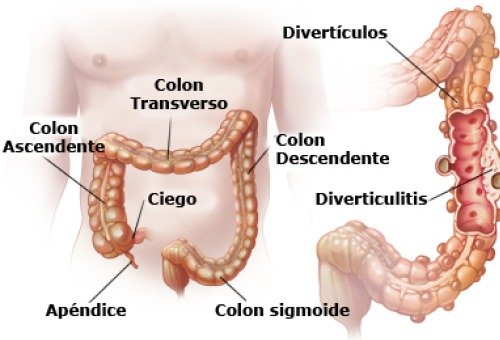Within the large bowel older people often develop pouches that fill up with fecal material. Most of the time people have them and don’t even know it. These pouches are called diverticula. When the diverticula are discovered, the doctor will diagnose the patient with diverticulosis. These pouches rarely cause problems, but when they become inflamed, they can also become infected, which may cause fever, nausea, abdominal pain and a change in the bowel pattern. When the diverticula become inflamed or infected the condition is called diverticulitis.
Diverticulitis can be very painful and can feel like appendicitis, except that the pain is generally on the left side. The patient may also have a fever, nausea and vomiting. Diverticula can form anywhere in the GI tract, even as far up as in the esophagus, but most generally they are found in the large intestine. Most people who have been diagnosed with diverticulosis never develop the more serious condition of diverticulitis. This is a condition that can be prevented by getting enough fiber in the daily diet.
Sometimes the colon develops weak spots and they give way to for pouches under pressure to be filled up with fecal matter. The pouches are most common in the sigmoid section and the descending colon which is why the pain is felt on the left side. The pouches may be very small at first, but they get larger as the fecal matter is pushed on through the colon. When the fecal matter becomes lodged in the pouches there may be a small perforation or tear, causing a fistula, that allows fecal material to spill out into the abdomen that in turn will cause an infection called peritonitis.
If your doctor suspects you might have diverticulitis, you will have blood tests drawn as well as to undergo diagnostic scans, such as a CT scan. Your doctor may want to do a colonoscopy, which visualizes the colon. If the diagnosis is confirmed, your doctor may order antibiotics for the infection. You may have to take a fiber supplement, and in some cases, if the condition is serious enough, your doctor may recommend surgery.
In most cases, those that can be treated at home, the doctor may suggest that you allow your colon to rest, so it can heal. You may be advised to avoid all grains, fruits and vegetables. You may be on a liquid diet or a very bland diet for a while. Then as your symptoms improve you may be able to gradually start increasing fiber in your diet.
Approximately one half of the patients diagnosed with diverticulitis are serious enough to be hospitalized. They are usually treated with IV antibiotics, especially if the patient is running a temp of 100 degrees or higher. If the patient has recurring episodes of diverticulitis that causes severe pain and infection within the abdomen, the doctor may encourage you to have surgery to have either a bowel resection or a colostomy.
To help prevent your ever developing diverticulitis be sure to eat the amount of fiber your doctor recommends. Drink plenty of water and get some exercise to keep your bowel healthy.
Source:
- Mayo Clinic – Information page
- Prescott Papers- Topics on Health

